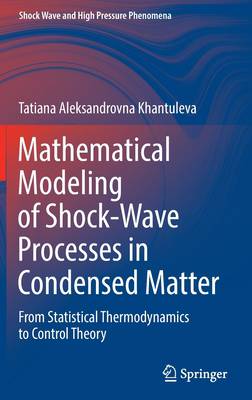
- Afhalen na 1 uur in een winkel met voorraad
- Gratis thuislevering in België vanaf € 30
- Ruim aanbod met 7 miljoen producten
- Afhalen na 1 uur in een winkel met voorraad
- Gratis thuislevering in België vanaf € 30
- Ruim aanbod met 7 miljoen producten
Mathematical Modeling of Shock-Wave Processes in Condensed Matter
From Statistical Thermodynamics to Control Theory
Tatiana Aleksandrovna KhantulevaOmschrijving
Chapter 1 Models of continuum mechanics and their deficiencies
1.1 Description of macroscopic systems; macroscopic variables
1.2 Macroscopic transport equations
1.3 The problem of closure of the transport equations
1.4 Validity of continuum mechanics
1.5 Scale averaging effect on transport processes
1.6 Medium models and transient processes
1.7 The problem of a uniform description of the media motions
1.8 Deficiencies of the continuum mechanics concept
1.9 Short review of approaches to extension of continuum mechanics
Chapter 2 Specific Features of Processes Far from Equilibrium
2.1 Experimental difficulties in studying non-equilibrium processes
2.2 Anomalous medium response to strong impact
2.3 The internal structure effects
2.4 Fluctuations, oscillations, instabilities
2.5 Multi-scale energy exchange between various degrees of freedom
2.6 Multi-stage relaxation processes
2.7 Finite speed of disturbances propagation and the delay effects
2.8 Influence of the loading duration and inertial effects
2.9 Dynamic self-organization of new internal structure in open systems
2.10 Predictive ability of modeling non-equilibrium processes
Chapter 3 Macroscopic Description in Terms of Non-equilibrium Statistical Mechanics
3.1 Fundamentals of statistical mechanics
3.2 Description of macroscopic systems from the first principles
3.3 Main problem of non-equilibrium statistical mechanics
3.4 Rigorous statistical approaches to non-equilibrium processes
3.5 Non-equilibrium statistical operator by Zubarev
3.6 Bogolyubov's hypothesis of attenuation of spatiotemporal correlations
3.7 The nonlocal thermodynamic relationships with memory between the conjugate macroscopic fluxes and gradients
3.8 Two type of the nonlocal effects
3.9 The disadvantages and new opportunities to close transport equations for high-rate processes
Chapter 4 Thermodynamic Concepts Out of Equilibrium
4.1 Basic concepts and principles of thermodynamics
4.2 Linear thermodynamics of irreversible processes
4.3 Revision of the generally accepted thermodynamic concepts out of equilibrium
4.4 Local entropy production near and far from equilibrium
4.5 Total entropy generation and the second law of thermodynamics
4.6 Maximum entropy principle by Jaynes
4.7 Thermodynamic temporal evolution out of equilibrium
4.8 Influence of the constraints imposed on the system
4.9 Self-organization of new structures in thermodynamics
Chapter 5 New Approach to Modeling Non-equilibrium Processes
5.1 Generalized constitutive relationships based on non-equilibrium statistical mechanics
5.2 Modeling spatiotemporal correlation functions
5.3 Temporal stages of the correlation attenuation
5.4 Deficiencies of the generally accepted models for the medium with complicated properties
5.5 Requirements to new approach to modeling shock-induced processes
5.6 Foundations of new approach to modeling transport processes far from equilibrium
5.7 New approach to modeling transport processes far from equilibrium
5.8 Distinctive features of new approach from semi-empirical models
5.9 Interrelationships between spatiotemporal correlations and dynamic structure of the system
5.10 Modeling correlation functions in boundary-value problems
5.11 Boundary conditions for nonlocal equations
5.12 The mathematical basis for the self-consistent problem formulation
5.13 Discrete size spectrum of the dynamic structure of a bounded system
Chapter 6 Description of the Structure Evolution Using Methods of Control Theory of Adaptive Systems
6.1 Methods of control theory in physics. Cybernetical physics
6.2 Speed gradient principle by Fradkov for non-stationary complex systems
6.3 Description of the system temporal evolution at macroscale level
6.4 Temporal evolution of statistical distribu
Specificaties
Betrokkenen
- Auteur(s):
- Uitgeverij:
Inhoud
- Aantal bladzijden:
- 336
- Taal:
- Engels
- Reeks:
Eigenschappen
- Productcode (EAN):
- 9789811924033
- Verschijningsdatum:
- 19/07/2022
- Uitvoering:
- Hardcover
- Formaat:
- Genaaid
- Afmetingen:
- 156 mm x 234 mm
- Gewicht:
- 671 g

Alleen bij Standaard Boekhandel
Beoordelingen
We publiceren alleen reviews die voldoen aan de voorwaarden voor reviews. Bekijk onze voorwaarden voor reviews.











